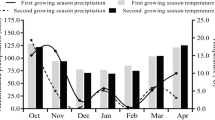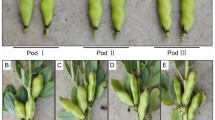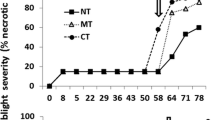Abstract
Knowledge about the critical production components and the key loss factors is essential for adequately managing the Common beans crop. Therefore, this study aimed to identify and quantify the losses in the production components, determining the critical components and key loss factors for three growing seasons and two planting systems and associating the loss factor in the production components with the relative abundance of insect pests on the Common beans crop. The planting system did not influence losses and productivity. Note that the lowest yields and highest losses were found in spring–summer. The critical production component was a flower for the winter–spring, spring–summer and summer–autumn seasons and ovules for the spring–summer period. Flower abortion was the key loss factor for the critical flower component, and ovule poor formation was the key loss factor for the critical ovule component.



Similar content being viewed by others
References
Ananthakrishnan TN (1993) Bionomics of thrips. Annu Rev Entomol 38:71–92. https://doi.org/10.1146/annurev.en.38.010193.000443
Araki H, Hamada A, Hossain MA, Takahashi T (2012) Waterlogging at jointing and/or after anthesis in wheat induces early leaf senescence and impairs grain filling. F Crop Res 137:27–36. https://doi.org/10.1016/j.fcr.2012.09.006
Aziz I, Mahmood T, Islam KR (2013) Effect of long term no-till and conventional tillage practices on soil quality. Soil Tillage Res 131:28–35. https://doi.org/10.1016/j.still.2013.03.002
Bacci L, Picanço MC, Gonring AHR et al (2006) Critical yield components and key loss factors of tropical cucumber crops. Crop Prot 25:1117–1125. https://doi.org/10.1016/j.cropro.2006.03.010
Blanco-Canqui H, Lal R (2008) No-tillage and soil-profile carbon sequestration: an on-farm assessment. Soil Sci Soc Am J 72:693–701. https://doi.org/10.2136/sssaj2007.0233
Boiça Júnior AL, Costa EN, De SBHS et al (2015) Infestation of Caliothrips phaseoli (Thysanoptera: Thripidae) on bean cultivars grown in the winter, rainy, and dry seasons in Brazil. Environ Entomol 44:1139–1148. https://doi.org/10.1093/ee/nvv100
Bonfim K, Faria JC, Nogueira EOPL et al (2007) RNAi-Mediated resistance to bean golden mosaic virus in genetically engineered Common beans (Phaseolus vulgaris). Mol Plant-Microbe Interact 20:717–726. https://doi.org/10.1094/MPMI-20-6-0717
Boutraa T, Sanders FE (2001) Influence of water stress on grain yield and vegetative growth of two cultivars of bean (Phaseolus vulgaris L.). J Agron Crop Sci 187:251–257. https://doi.org/10.1046/j.1439-037X.2001.00525.x
Brasil (1992) Regras para Análise de Sementes. Ministério da Agricultura e da Reforma Agrária. https://www.gov.br/agricultura/pt-br/assuntos/insumos-agropecuarios/arquivos-publicacoes-nsumos/2946_regras_analise__sementes.pdf Accessed 7 Sep 2020
Burd M (1998) “Excess” flower production and selective fruit abortion: a model of potential benefits. Ecology 79:2123–2132. https://doi.org/10.1890/0012-9658(1998)079[2123:EFPASF]2.0.CO;2
Cannon RJC, Matthews L, Collins DW (2007) A review of the pest status and control options for Thrips palmi. Crop Prot 26:1089–1098. https://doi.org/10.1016/j.cropro.2006.10.023
Carbonell SAM, Chiorato AF, de Resende MDV et al (2007) Estabilidade de cultivares e linhagens de feijoeiro em diferentes ambientes no estado de São Paulo. Bragantia 66:193–201. https://doi.org/10.1590/S0006-87052007000200003
Ceccon G, Raga A, Duarte AP, Siloto RC (2004) Efeito de inseticidas na semeadura sobre pragas iniciais e produtividade de milho safrinha em plantio direto. Bragantia 63:227–237. https://doi.org/10.1590/S0006-87052004000200008
da Cunha PCR, da Silveira PM, do Nascimento JL, AlvesJúnior J (2013) Manejo da irrigação no feijoeiro cultivado em plantio direto. Rev Bras Eng Agrícola e Ambient 17:735–742. https://doi.org/10.1590/S1415-43662013000700007
Dai Y, Shao M, Hannaway D et al (2009) Effect of Thrips tabaci on anatomical features, photosynthetic characteristics and chlorophyll fluorescence of Hypericum sampsonii leaves. Crop Prot 28:327–332. https://doi.org/10.1016/j.cropro.2008.11.012
De Barros EC, Ventura HV, Gontijo PC et al (2015) Ecotoxicological study of insecticide effects on arthropods in Common Bean. J Insect Sci. https://doi.org/10.1093/jisesa/ieu172
de Moura MF, Lopes MC, Pereira RR et al (2018) Sequential sampling plans and economic injury levels for Empoasca kraemeri on Common beans crops at different technological levels. Pest Manag Sci 74:398–405. https://doi.org/10.1002/ps.4720
Grassini P, Indaco GV, Pereira ML et al (2007) Responses to short-term waterlogging during grain filling in sunflower. F Crop Res 101:352–363. https://doi.org/10.1016/j.fcr.2006.12.009
Gross Y, Kigel J (1994) Differential sensitivity to high temperature of stages in the reproductive development of Common beans (Phaseolus vulgaris L.). F Crop Res 36:201–212. https://doi.org/10.1016/0378-4290(94)90112-0
Harman JA, Mao CX, Robinson LJ, Morse JG (2007) Evaluation of two non-destructive sampling methods for bean thrips (Thysanoptera: Thripidae) detection in navel oranges. Crop Prot 26:1747–1754. https://doi.org/10.1016/j.cropro.2007.03.003
Hoffmann Júnior L, Ribeiro ND, da Rosa SS et al (2007) Resposta de cultivares de feijão à alta temperatura do ar no período reprodutivo. Cienc Rural 37:1543–1548. https://doi.org/10.1590/S0103-84782007000600006
Jauer A, Dutra LMC, Zabot L et al (2006) Efeitos da população de plantas e de tratamento fitossanitário no rendimento de grãos do feijoeiro comum, cultivar “TPS Nobre.” Cienc Rural 36:1374–1379. https://doi.org/10.1590/S0103-84782006000500005
Jeyasankar A, Premalatha S, Jancy Rani S (2012) Bio-efficacy of Solanum pseudocapsicum L. (Solanaceae) against Black Cutworm, Agrotis ipsilon Hufnagel (Lepidoptera: Noctuidae). J Biol Sci 12:174–179. https://doi.org/10.3923/jbs.2012.174.179
Kokubun M, Shimada S, Takahashi M (2001) Flower abortion caused by preanthesis water deficit is not attributed to impairment of pollen in soybean. Crop Sci 41:1517–1521. https://doi.org/10.2135/cropsci2001.4151517x
Kozlowski J, Stearns SC (1989) Hypotheses for the production of excess zygotes: models of bet-hedging and selective abortion. Evolution 43:1369–1377. https://doi.org/10.1111/j.1558-5646.1989.tb02588.x
Kumar P, Pal M, Joshi R, Sairam RK (2013) Yield, growth and physiological responses of mung bean [Vigna radiata (L.) Wilczek] genotypes to waterlogging at vegetative stage. Physiol Mol Biol Plants 19:209–220. https://doi.org/10.1007/s12298-012-0153-3
Li J, Yuan R (2008) NAA and ethylene regulate expression of genes related to ethylene biosynthesis, perception, and cell wall degradation during fruit abscission and ripening in ‘delicious’ apples. J Plant Growth Regul 27:283–295. https://doi.org/10.1007/s00344-008-9055-6
Mariot EJ (1989) Ecofisiologia do feijoeiro. In: IAPAR (ed) O feijão no Paraná. IAPAR, Londrina
Miklas PN, Kelly JD, Beebe SE, Blair MW (2006) Common beans breeding for resistance against biotic and abiotic stresses: from classical to MAS breeding. Euphytica 147:105–131. https://doi.org/10.1007/s10681-006-4600-5
Morard P, Silvestre J (1996) Plant injury due to oxygen deficiency in the root environment of soilless culture: a review. Plant Soil 184:243–254. https://doi.org/10.1007/BF00010453
Muchero W, Ehlers JD, Roberts PA (2010) QTL analysis for resistance to foliar damage caused by Thrips tabaci and Frankliniella schultzei (Thysanoptera: Thripidae) feeding in cowpea [Vigna unguiculata (L.) Walp.]. Mol Breed 25:47–56. https://doi.org/10.1007/s11032-009-9307-6
Murata N, Takahashi S, Nishiyama Y, Allakhverdiev SI (2007) Photoinhibition of photosystem II under environmental stress. Biochim Biophys Acta Bioenerg 1767:414–421. https://doi.org/10.1016/j.bbabio.2006.11.019
Neves DVC, Lopes MC, Sarmento RA et al (2022) Economic injury levels for control decision-making of thrips in soybean crops (Glycine max (L.) Merrill). Res Soc Dev 11:e52411932114. https://doi.org/10.33448/rsd-v11i9.32114
Nolla A, Anghinoni I (2006) Critérios de calagem para a soja no sistema plantio direto consolidado. Rev Bras Ciênc do Solo 30:475–483. https://doi.org/10.1590/S0100-06832006000300009
Nunes UR, Santos NF, Farnezi MMM et al (2007) Qualidade fisiológica de sementes de feijão em plantio direto sobre diferentes coberturas de plantas em Diamantina, MG. Cienc e Agrotecnologia 31:1737–1743. https://doi.org/10.1590/S1413-70542007000600020
Pastenes C, Horton P (1999) Resistance of photosynthesis to high temperature in two bean varieties (Phaseolus vulgaris L.). Photosynth Res 62:197–203. https://doi.org/10.1023/A:1006391113097
Pereira JL, Picanço MC, Pereira EJG et al (2010) Influence of crop management practices on bean foliage arthropods. Bull Entomol Res 100:679–688. https://doi.org/10.1017/S0007485310000039
Peuke Ad, Gessler A, Trumbore S et al (2015) Phloem flow and sugar transport in Ricinus communis L. is inhibited under anoxic conditions of shoot or roots. Plant Cell Environ 38:433–447. https://doi.org/10.1111/pce.12399
Plaut Z, Butow B, Blumenthal C, Wrigley C (2004) Transport of dry matter into developing wheat kernels and its contribution to grain yield under post-anthesis water deficit and elevated temperature. F Crop Res 86:185–198. https://doi.org/10.1016/j.fcr.2003.08.005
Rogers DJ, Brier HB (2010) Pest-damage relationships for Helicoverpa armigera (Hübner) (Lepidoptera: Noctuidae) on soybean (Glycine max) and dry bean (Phaseolus vulgaris) during pod-fill. Crop Prot 29:47–57. https://doi.org/10.1016/j.cropro.2009.08.015
Sandhu HS, Nuessly GS, Webb SE et al (2010) Temperature-dependent development of Elasmopalpus lignosellus (Lepidoptera: Pyralidae) on sugarcane under laboratory conditions. Environ Entomol 39:1012–1020. https://doi.org/10.1603/EN09284
dos Santos RLL, Corrêa JBD, de Andrade MJB, de Morais AR (2004) Comportamento de cultivares de feijoeiro-comum em sistema convencional e plantio direto com diferentes palhadas. Cienc e Agrotecnologia 28:978–989. https://doi.org/10.1590/S1413-70542004000500003
Sas (2020) SAS Enterprise Guide. https://support.sas.com/en/software/enterprise-guide-support.html. Accessed 7 Sep 2020
Singh RP, Prasad PVV, Sunita K et al (2007) Influence of high temperature and breeding for heat tolerance in cotton: a review. Adv Agron 93:313–385. https://doi.org/10.1016/S0065-2113(06)93006-5
Sinha R, Fritschi FB, Zandalinas SI, Mittler R (2021) The impact of stress combination on reproductive processes in crops. Plant Sci 311:111007. https://doi.org/10.1016/j.plantsci.2021.111007
Soratto RP, de Carvalho MAC, Arf O (2006) Nitrogênio em cobertura no feijoeiro cultivado em plantio direto. Rev Bras Ciênc do Solo 30:259–266. https://doi.org/10.1590/S0100-06832006000200007
Srivastava N, Kumar G (2016) Effect of waterlogging stress on meiotic course, tetrad formation and pollen fertility of sesbania pea. Tsitol Genet 50:36–39 (PMID: 27266183)
Tadege M, Kuhlemeier C (1997) Aerobic fermentation during tobacco pollen development. Plant Mol Biol 35:343–354. https://doi.org/10.1023/a:1005837112653
Takeoka Y, Hiroi K, Kitano H, Wada T (1991) Pistil hyperplasia in rice spikelets as affected by heat stress. Sex Plant Reprod 4:39–43. https://doi.org/10.1007/BF00194570
Tang R-S, Zheng J-C, Jin Z-Q et al (2007) Possible correlation between high temperature-induced floret sterility and endogenous levels of IAA, GAs and ABA in rice (Oryza sativa L.). Plant Growth Regul 54:37–43. https://doi.org/10.1007/s10725-007-9225-8
Teixeira MLF, Franco AA (2007) Infestação por larvas de Cerotoma arcuata (Olivier) (Coleoptera: Chrysomelidae) em nódulos de feijoeiro em cultivo com cobertura morta ou em consórcio com milho ou com caupi. Cienc Rural 37:1529–1535. https://doi.org/10.1590/S0103-84782007000600004
Ter Braak CJF, Smilauer P (1998) Reference manual and users guide to CANOCO for Windows: software for canonical community ordination. Microcomputer Power, Ithaca
Tinsley NA, Estes RE, Gray ME (2013) Validation of a nested error component model to estimate damage caused by corn rootworm larvae. J Appl Entomol 137:161–169. https://doi.org/10.1111/j.1439-0418.2012.01736.x
Turc O, Tardieu F (2018) Drought affects abortion of reproductive organs by exacerbating developmentally driven processes via expansive growth and hydraulics. J Exp Bot 69:3245–3254. https://doi.org/10.1093/jxb/ery078
Varley GC, Gradwell GR (1960) Key factors in population studies. J Anim Ecol 29:399–401
Varvel GE, Wilhelm WW (2011) No-tillage increases soil profile carbon and nitrogen under long-term rainfed cropping systems. Soil Tillage Res 114:28–36. https://doi.org/10.1016/j.still.2011.03.005
Vieira C, Paula Junior TJ de PJ, Borém A (2013) Feijão, 2°. Editora UFV, Viçosa, MG.
Vilca Mallqui KS, Oliveira EE, Guedes RNC (2013) Competition between the bean weevils Acanthoscelides obtectus and Zabrotes subfasciatus in common beans. J Stored Prod Res 55:32–35. https://doi.org/10.1016/j.jspr.2013.07.004
Wahid A, Gelani S, Ashraf M, Foolad M (2007) Heat tolerance in plants: an overview. Environ Exp Bot 61:199–223. https://doi.org/10.1016/j.envexpbot.2007.05.011
Waraich E, Ahmad R, Halim A, Aziz T (2012) Alleviation of temperature stress by nutrient management in crop plants: a review. J Soil Sci Plant Nutr 12:221–244. https://doi.org/10.4067/S0718-95162012000200003
Whittle CA, Otto SP, Johnston MO, Krochko JE (2009) Adaptive epigenetic memory of ancestral temperature regime in Arabidopsis thaliana. Botany 87:650–657. https://doi.org/10.1139/B09-030
Wilmowicz E, Frankowski K, Kućko A et al (2016) The influence of abscisic acid on the ethylene biosynthesis pathway in the functioning of the flower abscission zone in Lupinus luteus. J Plant Physiol 206:49–58. https://doi.org/10.1016/j.jplph.2016.08.018
Acknowledgements
The authors have gratitude for the Coordination for the Improvement of Higher Education Personnel—Brazil (CAPES) funding code 001, the National Council for Scientific and Technological Development (CNPq), and the Foundation for Supporting Research in the state of Minas Gerais (FAPEMIG).
Author information
Authors and Affiliations
Contributions
BEC conducted this research, collected the necessary data and did analysis of the data and wrote draft paper. PMC idealizer and project manager. PRR field evaluation and conducted field studies. CM field evaluation and conducted field studies. DPGP corrected the final paper. DSJAAS corrected the final paper.
Corresponding author
Ethics declarations
Conflict of interest
The authors declare that they have no conflict of interest.
Additional information
Publisher's Note
Springer Nature remains neutral with regard to jurisdictional claims in published maps and institutional affiliations.
Rights and permissions
Springer Nature or its licensor (e.g. a society or other partner) holds exclusive rights to this article under a publishing agreement with the author(s) or other rightsholder(s); author self-archiving of the accepted manuscript version of this article is solely governed by the terms of such publishing agreement and applicable law.
About this article
Cite this article
de Barros, E.C., Picanço, M.C., Pereira, R.R. et al. Key loss factors and critical components of Common beans in tropical regions under different growing season and planting systems. Agric Res 12, 408–420 (2023). https://doi.org/10.1007/s40003-023-00663-w
Received:
Accepted:
Published:
Issue Date:
DOI: https://doi.org/10.1007/s40003-023-00663-w




